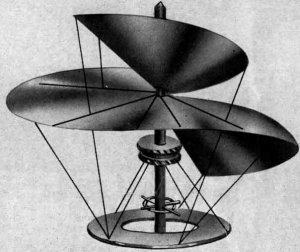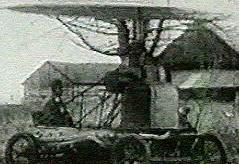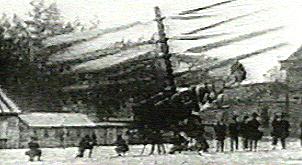The first concept of rotary wing aviation came from the Chinese in the fourth century A.D.
A book called "Pao Phu Tau" tells of the "Master" describing flying cars (fei chhe) with
wood from the inner part of the jujube tree with ox-leather straps fastened to returning
blades as to set the machine in motion (huan chien i yih chhi chi). This is the first recorded
pattern of what we might understand as a helicopter.
“The technology needed to create a helicopter had not been produced yet but the concept of rotary wing aviation had unquestionably been found.” John Fay
 400 BC :
Chinese tops
A toy, consisted of feathers at the end of a stick, which was rapidly spun between
the hands to generate lift and then released into free flight.
These toys were probably inspired by observations of the autorotating seeds of trees such as the Sycamore.
400 BC :
Chinese tops
A toy, consisted of feathers at the end of a stick, which was rapidly spun between
the hands to generate lift and then released into free flight.
These toys were probably inspired by observations of the autorotating seeds of trees such as the Sycamore.
 1480 :
Leonardo Da Vinci 's Helical Air Screw
1480 :
Leonardo Da Vinci 's Helical Air Screw
"...I have discovered that a screw-shaped device such as this,
if it is wellmade from starched linen,
will rise in the air if turned quickly..."
Leonardo Da Vinci - Codice Atlantico

 A wide amount of minor inventions contributed to the advancement of the helicopter
between the fifteenth and twentieth centuries ...
All models at this time lacked suitable power to achieve flight and were both bulky and heavy.
A wide amount of minor inventions contributed to the advancement of the helicopter
between the fifteenth and twentieth centuries ...
All models at this time lacked suitable power to achieve flight and were both bulky and heavy.


The precision of parts due to the Industrial Revolution enabled the helicopter to evolve into the modern machines we see flying today. The need of accurate machinery and fixtures was evident when the earliest helicopter models lacked the efficiency and flying capability of modern helicopters.
 1754 :
Mikhail Lomonosov ( Czarist Russia )
He suggest a coaxial rotor machine to elevate meteorological
instruments. It was modeled after the chinese toy but powered
by a wound-up spring device.
The device flew freely and climbed to a good altitude.
1754 :
Mikhail Lomonosov ( Czarist Russia )
He suggest a coaxial rotor machine to elevate meteorological
instruments. It was modeled after the chinese toy but powered
by a wound-up spring device.
The device flew freely and climbed to a good altitude.
 1784, April 28 :
Launoy / Bienvenu ( France )
Another version of the chinese toy,
which has at each end of its fuselage a two-bladed propeller driven by a bowdrill system.
Was a model consisting of a counter rotating set of turkey feathers that
could take off and fly using its own power. This proves that an object which is heavier than air could fly.
1784, April 28 :
Launoy / Bienvenu ( France )
Another version of the chinese toy,
which has at each end of its fuselage a two-bladed propeller driven by a bowdrill system.
Was a model consisting of a counter rotating set of turkey feathers that
could take off and fly using its own power. This proves that an object which is heavier than air could fly.
 1800 :
Sir George Cayley ( UK )
Already famous for his work on the basic principles of flight,
which dates from the 1790s, had constructed several successful vertical-flight
models with rotors made of sheets of tin and driven by wound-up clock springs.
1800 :
Sir George Cayley ( UK )
Already famous for his work on the basic principles of flight,
which dates from the 1790s, had constructed several successful vertical-flight
models with rotors made of sheets of tin and driven by wound-up clock springs.
In a scientific paper, published in 1843, Cayley mention a vertical flight machine called "Aerial Carriage." However, Cayley's device remained an idea because the only power plants available at the time were steam engines, and these were much too heavy to allow for successful powered flight.
 1842 :
W. H. Phillips ( UK ) Build a 10 kg steam-powered model.
1842 :
W. H. Phillips ( UK ) Build a 10 kg steam-powered model.
 1845 :
Cossus ( France ) A steam machine, uses a main rotor and other two smallest.
1845 :
Cossus ( France ) A steam machine, uses a main rotor and other two smallest.
 1861 :
Bright Uses a globe over the rotors
1861 :
Bright Uses a globe over the rotors

 1863, Sept 24 :
Viscount Gustave de Ponton d'Amecourt ( France )
In a 40-page monograph entitled :
1863, Sept 24 :
Viscount Gustave de Ponton d'Amecourt ( France )
In a 40-page monograph entitled :
"La Conquete de l'air par l'helice.
Expose d'un nouveau systeme d'aviation"
published in Paris,
he put together the Greek words helico and pteron,
meaning "spiral" and "wing", to make the word helicoptere.
 1877 : E.Forlanini ( Italia )
With a small steam engine (3.5 kgs), his model reach 9 meters and remains in flight for 30 seconds.
1877 : E.Forlanini ( Italia )
With a small steam engine (3.5 kgs), his model reach 9 meters and remains in flight for 30 seconds.
 1880 : Thomas Edison
He tries with an electric engine. The machine was unpowered but
he was sure that helicopters will be very important in the future
1880 : Thomas Edison
He tries with an electric engine. The machine was unpowered but
he was sure that helicopters will be very important in the future
 1895 : De los Olivos A tandem rotors helo with wings
1895 : De los Olivos A tandem rotors helo with wings
“The technology needed to create a helicopter had not been produced yet but the concept of rotary wing aviation had unquestionably been found.” John Fay
if it is wellmade from starched linen,
will rise in the air if turned quickly..."
Leonardo Da Vinci - Codice Atlantico
His theory for "compressing" the air and obtain lift was substantially similiar
to that for today s helicopters.
Often been cited as the first serious attempt to produce a working helicopter, Da Vinci 's was only an experimental design and was never put into practical use. Was clearly far ahead of its time, but without adequate technology the ability to create such machines was virtually impossible.
His sketch of the aerial screw or air gyroscope device is dated to 1483 but it was first published nearly three centuries later.
A scale model (currently exposed at the Science Museum of London) recently built with the original Da Vinci plans was not successful to raise itself in flight.
Often been cited as the first serious attempt to produce a working helicopter, Da Vinci 's was only an experimental design and was never put into practical use. Was clearly far ahead of its time, but without adequate technology the ability to create such machines was virtually impossible.
His sketch of the aerial screw or air gyroscope device is dated to 1483 but it was first published nearly three centuries later.
A scale model (currently exposed at the Science Museum of London) recently built with the original Da Vinci plans was not successful to raise itself in flight.



The precision of parts due to the Industrial Revolution enabled the helicopter to evolve into the modern machines we see flying today. The need of accurate machinery and fixtures was evident when the earliest helicopter models lacked the efficiency and flying capability of modern helicopters.
In a scientific paper, published in 1843, Cayley mention a vertical flight machine called "Aerial Carriage." However, Cayley's device remained an idea because the only power plants available at the time were steam engines, and these were much too heavy to allow for successful powered flight.

